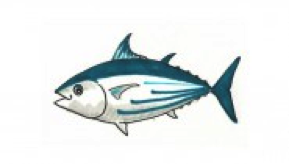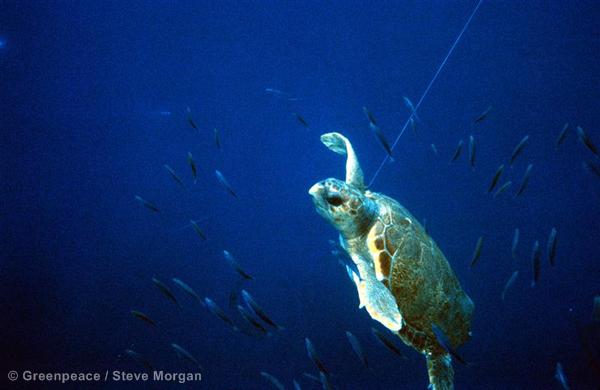Use this quick guide to get to know the fish on your plate.
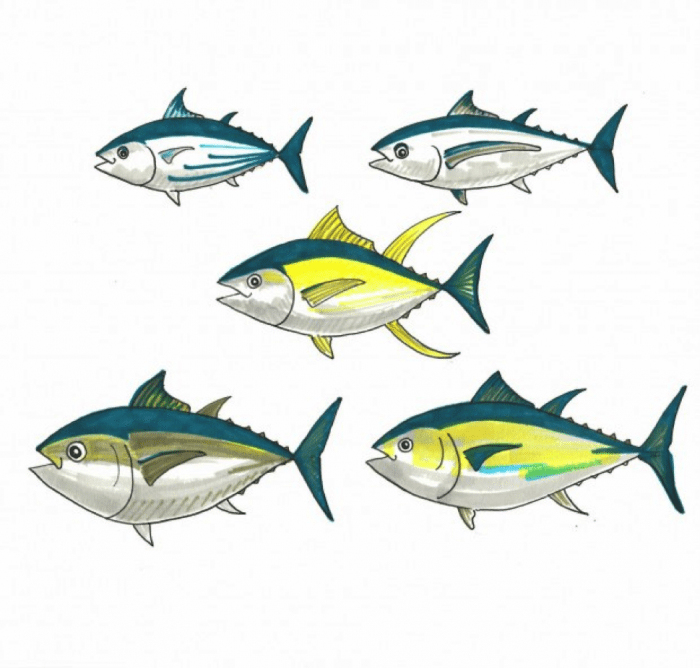
Tuna are wild animals, but many people simply understand them as food. Using the shorthand ‘tuna’ can bit confusing, as it tends to cover a whole family of species, from the relatively small and widespread skipjack, right up to the majestic and beleaguered bluefin.
So I’ve pulled together a quick guide to the tuna species youre likely to encounter in either the U.S. or Europe.
This is not intended to encourage you to eat them but toraise awareness of what it is that is being served up. If you’re going to eat tuna responsibly, here are some issues you need to think about.
There are about 15 species of tuna recognised worldwide, but you are likely to only encounter these five:
SKIPJACK (Katsuwonas pelamis)
Relatively small, and the most abundant and widely-fished of tuna species. The fish can be up to a meter in length, but is rarely recognisable when served up. It makes up over 70% of the American canned tuna market (often called chunk light). Tuna chunks and flakes in brine or oil, on a sandwich, baked potato, or pizza? Safe bet its skipjack.
It’s a pretty abundant species, but there are still issues around how it is fished. In particular, fishing methods indiscriminately harm other species, which end up as bycatch.
Most skipjack is caught using large purse-seine nets. When these are set around Fish-Aggregation-Devices (or FADs, which are really
just floating structures that act like fish magnets) they result in huge amounts of bycatch of other fish, as well as sharks, rays, even seaturtles, and, occasionally, whales or dolphins. Using FADs has been shown to increase the amount of bycatch tenfold.
The famous dolphin safe logo on tuna may tell you that its not caught in a way that deliberately catches or sets nets around dolphins, but its no guarantee. And of course, ‘dolphin safe’ tells you nothing about impacts on other species.

A net bulging with tuna and bycatch on the Ecuadorean purse seiner ‘Ocean Lady’, which was spotted by Greenpeace in the vicinity of the northern Galapagos Islands while using fishing aggregating devices (FADs).
Sadly, many of the species caught and killed as bycatch are endangered including several species of open ocean sharks and sea turtles. And when you factor in the scale of the fishing operation to fill those little cans, that adds up to a whole lot of collateral damage, including tens of millions of sharks every year.
Luckily, there are better, cleaner ways to catch skipjack. Look out for pole-and-line caught skipjack, or tuna that has been caught without using FADs.
 YELLOWFIN (Thunnus albacares)
YELLOWFIN (Thunnus albacares)
Yellowfin are widespread and magnificently-streamlined fish. And, yes, they have yellow fins, including characteristically sickle-shaped elongated go faster ones. They are found around the world but mostly confined to tropical waters. They can grow to over 2 meters in length.
Yellowfin tuna can be found either in cans or sold fresh and frozen as tuna steaks. You may also find it in sushi. The package should tell you what species it is (if it doesnt, dont buy it!).
Like skipjack, yellowfin are caught with purse seines, and when FADs are used the vast majority are young yellowfin that never get a chance to breed. Another method of catching them is using longlines: lines of baited hooks that can be many miles long. This method of fishing can be very indiscriminate and responsible for lots of bycatch sharks, swordfish, turtles, and seabirds can all fall victim to the baited hooks. Longlining is the main reason that global albatross populations are endangered, and as with purse seining, some of the species caught and killed are endangered sharks and turtles too.
There are ways to make longlining better, but the safest way to know that your yellowfin hasnt come at the cost of lots of other animals lives is to look for pole & line caught.
However, there are now real concerns that populations of yellowfin have been totally overfished, and in many places are still plummeting.
TOP TIP only choose pole & line caught yellowfin, and eat it sparingly.
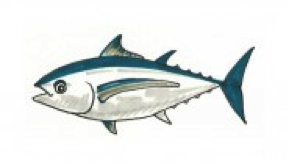 ALBACORE (Thunnus alalunga)
ALBACORE (Thunnus alalunga)
Albacore is a cooler water tuna, and it even ventures into waters off the U.S.s west and east coasts. They have an unusually long pectoral fin and are sometimes referred to as white tuna, because of their pale flesh.
Albacore tuna is often sold as solid white albacore in cans. They make up approximately 20% of the U.S. shelf-stable tuna market.
Albacore is mainly caught on longlines, but they can be caught with much more ocean-friendly methods, such as pole & line and a similar method called trolling.
Most populations of albacore have been totally overfished. The only relatively healthy stocks are in the Pacific, but these are in decline.
TOP TIP choose pole & line or ‘trolled’ albacore, from the Pacific.
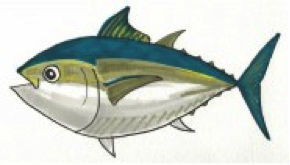 BIGEYE (Thunnus obesus)
BIGEYE (Thunnus obesus)
This is a big, robust fish, found in tropical waters and growing over 2 metres in length. Sadly, bigeye tuna are in trouble, with many populations plummeting in recent years due to overfishing. Its caught in similar ways to the similarly-sized yellowfin, and while you might encounter it served up as tuna steaks, its much more likely you’ll find it served as sushi. It is one of the two species known as ‘ahi,’ along with yellowfin.

Schools of fish circle a fish aggregation device (FAD) floating and continuously attracting fish during a banned FAD fishing season in the Western and Central Pacific ocean in 2009.
Unfortunately, even canned chunk light tuna may contain bigeye. This may actually be because juvenile bigeye are being caught in purse seining nets alongside the smaller skipjack (this also happens with juvenile yellowfin.) Catching juvenile tuna, from threatened or overfished stocks, is a big problem because they are caught before they have had chance to breed.
TOP TIP AVOID BIGEYE (and avoid conventionally-sourced canned chunk light tuna)
 BLUEFIN (Thunnus maccoyii, Thunnus orientalis & Thunnus thynnus)
BLUEFIN (Thunnus maccoyii, Thunnus orientalis & Thunnus thynnus)
There are three species of bluefin tuna: Southern, Pacific, and Atlantic, and they are spectacular fish. Growing to over 3 meters, and weighing up to a whopping 1,000 pounds, they are warm-blooded top predators that can accelerate faster than a sports car. They can tolerate warm and cold water. They are found along the coasts of the U.S.
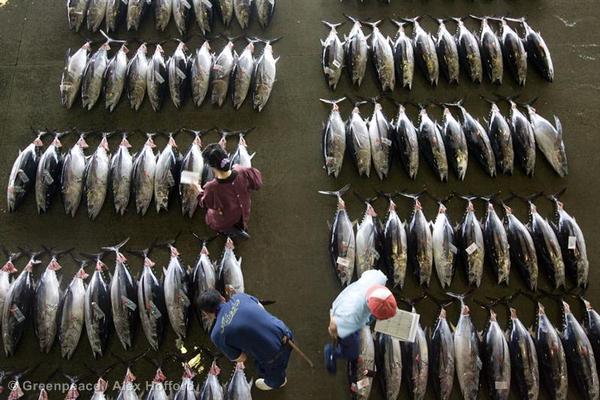
Critically endangered bluefin tuna is seen being traded on the dock at the port of Kesen-numa City, Miyagi Prefecture, North East Japan.
In recent years bluefin tuna has been severely overfished. Atlantic and Southern bluefin are already classified as endangered, andPacific bluefin populations are at only 4% of historic levels. Traditional methods of catching them in traps and on lines have given way to large purse-seining catches targeting them as they come together to spawn. The fashion for sushi has driven this demand. As they get ever scarcer and ever more expensive there are real concerns for the future of bluefin.
In the U.S. you should only find bluefin in relatively expensive sushi. It may be labelled as o-toro.
TOP TIP AVOID BLUEFIN

